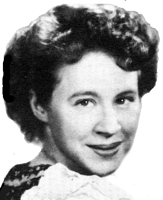
|
The Society of Folk Dance Historians (SFDH) Changier Quadrille
[
Home |
About |
Encyclopedia | CLICK AN IMAGE TO ENLARGE |
Information: A dance.
Pronunciation: shawn-ZHAIR ka-DREE-ye
Region: Germany
Source: Wilhelm Wulf(f?) collected this North German dance, perhaps from Lubeck, and taught it to Jane Farwell in 1958 who taught it to dancers in the United States shortly thereafter.
Meter: 2/4
Formation: Square of 4 couples, numbered CCW: C1, C3, C2, C4. C1 has their backs to the music.
| BARS | ACTION | |
| Introduction. |
| chord | You may acknowledge your partner with a bow (for the men) or curtsy (for the women). |
| Verse 1. | Circle L and R. Join hands at shoulder height. |
| 1-16 | Starting onto L ft: walk 16 steps to L & 16 steps to R, CW & CCW around your circular square. |
| Note: | During bar 9, a typical German change of direction step would be: facing to L, step back onto L ft (ct 1), turning to face center, step to R onto R ft (ct 2). Finish turning and continue walking to R. |
| Verse 2. | Chorus: Changier and chain. Join near hands with corner and let go partner. |
| 1-4 | Couples 3 & 4 dance passive path; couples 1 & 2 dance active path. Partners meet & change places on opposite side of square as the woman turns 1/4 CCW under joined R hands. (Active women precede active men through sides.) |
| 5-8 | Couple 1 changes places with couple 2, giving R hands and passing R shoulders. In original positions, turn by the L hand 1/2 with partner CCW. |
| 9-16 | Repeat action of bars 1-8, couples 1 & 2 reversing roles with couples 3 & 4. |
| 17-22 | Face partner. Dance rights and lefts around the square to meet your partner. |
| 23-24 | Turn partner by the R hand (thumb grip) with 3 steps onto: L ft, R ft, L ft (cts 1,2,1), balance away from partner by stepping back onto R ft (ct 2). |
| 25-30 | Repeat action of bars 17-22. |
| 31-32 | Turn partner by the R hand (thumb grip) once 'round with 4 steps. |
| Note: | Note: the Changier active figure may be done with this step: 2 linear polka steps (bars 1,2), and 4 walking steps (bars 3,4). |
| Now, since no mortal could possibly understand the foregoing 32 bars in writing, here they are in diagramatic form: |
| Verse 2. | Couples 1 & 2 solo. |
| 1-6 | Couple 1, in ballroom position, dances 6 turning polka steps CCW around the inside of the square. Others clap thrice during each bar (cts 1,&,2). |
| 7-8 | Couple 1 turns twice in place with 4 pivot steps. Others clap (cts 1,2,1,2). |
| 9-16 | Repeat action of bars 1-8 but couple 2 solos (or duets). |
| Repeat the chorus. |
| Verse 3. | Couples 3 & 4 solo. |
| 1-16 | Repeat action of part 2, but couples 3 & 4 polka (sequentially, not simultaneously) instead of couples 1 & 2. |
| Repeat the chorus. |
| Verse 4. | Double your pleasure, double your fun . . . |
| 1-16 | Couples 1 & 2 simultaneously polka and pivot, then couples 3 & 4. |
| Repeat the chorus. |
| Verse 5. | Finale: Circle and polka. Join hands at shoulder height. |
| 1-8 | Starting with L ft, dance 8 linear polka steps to L, CW around circular square. |
| 9-16 | Partners, in ballroom position, return to places with 8 (not 6) turning polka steps. |
REFERENCE
- Folk Dance Problem Solver (1987), Society of Folk Dance Historians (SFDH), San Antonio, TX. Changier Quadrille.
DOCUMENTS
- Germany, a country.
- Jane Farwell, an article.
This page © 2018 by Ron Houston.
Please do not copy any part of this page without including this copyright notice.
Please do not copy small portions out of context.
Please do not copy large portions without permission from Ron Houston.
